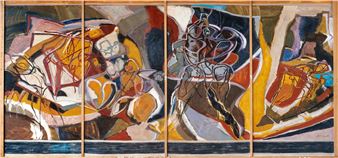A.N.T.H.R.O.P.O.C.E.N.E
The term Anthropocene was introduced for the first time in 2000 by climatologist Paul Crutzen. This concept, now recognized by the international scientific community, means that the human race has become a geological force in its own right. Its effects on the elements that constitute the Earth (water, air, land) have become so great that ãSystem Earthã has undergone irremediable disruption and has begun an irreversible mutation. We are leaving one world and entering another.
The beginning of the Anthropocene is generally estimated to have been in about 1800, at the start of the Industrial Revolution in Europe. An infinitesimal period, almost zero in comparison with the history of Earth, was enough to cause a change comparable to the major upheaval that separates us from the Mesozoic era. Earth time has become measurable in the time of human action.
Scientists, philosophers and anthropologists as well as artists are joining forces to stress that there is an environmental emergency. The boundaries of knowledge are being re-drawn and this new era allows us a glimpse of new possibilities. In that respect, it is a fascinating mutation.
What resources and protective mechanisms does humanity have to cope with this new epoch? How can humanity contend with a change on this scale? How can we live on Earth?
The artists invited for this group exhibition draw attention to the issue and come up with new ways of thinking and change our modes of perception in order to be able to respond to what is happening.

Recommended for you
The term Anthropocene was introduced for the first time in 2000 by climatologist Paul Crutzen. This concept, now recognized by the international scientific community, means that the human race has become a geological force in its own right. Its effects on the elements that constitute the Earth (water, air, land) have become so great that ãSystem Earthã has undergone irremediable disruption and has begun an irreversible mutation. We are leaving one world and entering another.
The beginning of the Anthropocene is generally estimated to have been in about 1800, at the start of the Industrial Revolution in Europe. An infinitesimal period, almost zero in comparison with the history of Earth, was enough to cause a change comparable to the major upheaval that separates us from the Mesozoic era. Earth time has become measurable in the time of human action.
Scientists, philosophers and anthropologists as well as artists are joining forces to stress that there is an environmental emergency. The boundaries of knowledge are being re-drawn and this new era allows us a glimpse of new possibilities. In that respect, it is a fascinating mutation.
What resources and protective mechanisms does humanity have to cope with this new epoch? How can humanity contend with a change on this scale? How can we live on Earth?
The artists invited for this group exhibition draw attention to the issue and come up with new ways of thinking and change our modes of perception in order to be able to respond to what is happening.
Artists on show
- Adam Henry
- Aurélien Froment
- Benoît Maire
- Benoit Pype
- Chaim Van Luit
- Claudio Parmiggiani
- Ellen Harvey
- Evariste Richer
- Fabrice Samyn
- Filip Gilissen
- Guillaume Leblon
- Hreinn Fridfinnsson
- Ignasi Aballi
- Jordi Colomer
- Jorge Méndez Blake
- José Maria Sicilia
- Katinka Bock
- Kelly Schacht
- Leon Vrancken
- Lieven De Boeck
- Lucy Skaer
- Maarten van den Eynde
- Milena Bonilla
- Navid Nuur
- Nicolás Lamas
- Ryan Foerster
- Ryan Gander
- Susan Collis
- Tania Pérez Córdova
- Thu Van Tran
- Vanessa Billy
- Wilfredo Prieto
















